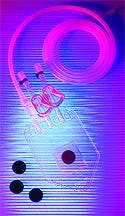March 3, 2007
Originally Published MPMN March 2007
HOTLINE
Read-Write RFID Tag Withstands Gamma Sterilization Process
|
A read-write RFID tag for single-use components enables tracking of the product at every stage, from manufacture to gamma sterilization to end use. |
While promoting a radio-frequency identification (RFID) tag for tracking hoses in pharmaceutical processing plants, AdvantaPure (Southampton, PA; www.advantapure.com) encountered significant interest from other markets desiring the technology for their own tracking needs. The company happily accommodated requests and tailored the tag for use on pumps and valves. But when manufacturers of single-use products expressed interest in an RFID solution for bioprocessing bags, one obstacle stood in the way: compatibility
with gamma sterilization.
Identification of disposables undergoing gamma sterilization has posed a number of problems in the past, according to Jeff Johnson, director of software development. Tracking often requires the labeling of a product prior to sterilization and then again after processing because the tag could not withstand the exposure to gamma rays, he says.
“We put our heads down and said: ‘Oh well, we tried on that application.’ Basically, gamma sterilization and computer chips don’t mix,” says Ken Baker, CEO for AdvantaPure. “Then we started talking to everybody and anybody about this and finally came up with a solution. After discussion, R&D money, and coming up with the right configuration for environmental [compatibility]—not only gamma, but also temperature and cold—we came up with this chip.”
Suited for single-use products, the GammaTag is a gamma-sterilizable RFID chip equipped with read-write capabilities. Measuring 25 mm in diameter and 2 mm thick, the tag withstands gamma radiation up to 45 kGy and temperatures ranging from –20° to 85°C. Using silicone tape, a watchband-style holder, pouch, or lamination, the tag attaches to such disposable products as sample and production bags, manifolds, tubing and hose, filters, and single-use systems.
It also enables the gamma sterilization of a single-use process system as a complete unit.
“By having a tag that can actually go through the process and retain its data, you can have a fully sterilized, yet fully identifiable, lot-traceable item,” Johnson explains. “We can write information on the tag relating to the part number, the serial number, the lot number, or any of the manufacturer’s information and it doesn’t get separated from the product at any point throughout production or sterilization.”
Whereas bar codes and tags are read-only identification products, GammaTag allows manufacturers to write data directly on the tag for accurate and updated product tracking. The chip accommodates 2 Kb of memory. Using a handheld tag reader and software, users can also access such data as certifications, instructions, warning notices, and disposal procedures.
“Right now, the best way of tracking items going through gamma sterilization is through a log book, or with paper, which is fundamentally flawed on many different levels,” Baker says. “This allows an end-user to really have that confidence in removing the risk of tracking a disposable—whether it is a bag, a filter, or a medical device—all the way through from manufacture to sterilization to end use.”
Copyright ©2006 Medical Product Manufacturing News
You May Also Like



